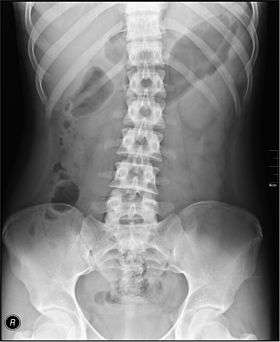Abdominal x-ray
| Abdominal x-ray | |
|---|---|
| Intervention | |
 | |
| ICD-9-CM | 87.5,87.9, 88.0-88.1 |
| MedlinePlus | 003815 |
An abdominal x-ray is an x-ray of the abdomen. It is sometimes abbreviated to AXR, or KUB (for kidneys, ureters, and urinary bladder).
Diagnostic tool
The abdominal x-ray is a test that can be carried out quickly and easily in an emergency department. The test can help diagnose some abdominal conditions. It is not a useful investigation for most abdominal conditions. Small and large bowel obstructions, volvulus and malrotations can be diagnosed by AXR. Renal, urethral and bladder stones can sometimes be identified on plain x-ray, although it is usual now to use CT as a first line investigation to confirm clinical suspicion. Gallstones are sometimes noted on x-ray, although ultrasound is the more usual imaging modality used when clinically suspected. Plain abdominal radiography is not usually helpful in diagnosis of appendicitis.
Technical parameters
An abdominal x-ray is usually taken with the patient lying in a supine position. Other views include upright, decubitus, lateral, and prone. Coverage on the x-ray should include from the top of the Liver (or diaphragm) to the pubic symphysis. The abdominal organs included on the xray are the liver, spleen, stomach, intestines, pancreas, kidneys, and bladder.
Pathology
In an acute setting, the abdominal x-ray is used to diagnose:
- Bowel obstruction with air fluid levels generally seen on x-ray.
- Bowel perforation, although this is more commonly diagnosed by a chest x-ray
- Kidney stones or gall stones: Further tests are used to confirm these diagnoses and abdominal x-ray is not the investigation of choice
- Faecal impaction, although this should be diagnosed by history taking and clinical examination
| Wikimedia Commons has media related to Abdominal X-rays. |